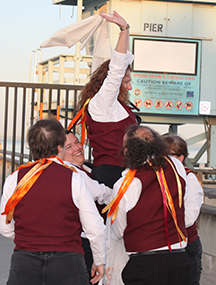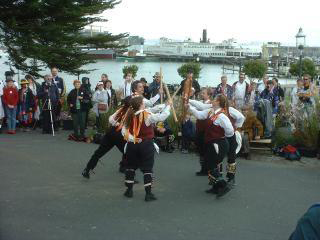
Santa Monica based
Mixed Morris Dance Group

What is Morris Dancing?
Briefly, the Cotswold morris is a traditional folk dance which was found in small villages around Oxford, England at the end of the 19th century. It was a central part of annual springtime rituals throughout the region. The dancers wear dozens of bells on each leg, wield sticks and/or handkerchiefs, and dance to lively folk tunes.What is it like?
it is a high-impact, aerobic form of dance done to live music by teams (or sides) of four or six who are all dressed in brightly colored kit. The stepping is done in a style designed to maximize the ringing of the bells whilst minimizing the danger of impact injury. Some dances consist of 6 solid minutes of stepping and are more strenuous than running for a mile. Dances done while waving handkerchiefs often contain spectacular leaps high into the air. Dances done with clashing of sticks could have nasty consequences to dancers or audience.What Morris is not
from Cecil Sharp's Morris Book, part I:"The Morris is not an easy dance...It is not everyone's dance, nor has it ever been so regarded by traditional dancers.""The Morris is not a social dance--one, that is, which is danced chiefly for pleasure. It is, primarily, a spectacular dance; its purpose is, or was, to provide an exhibition or pageant at holiday time for the entertainment of the onlooker. It was, too, a professional dance.''